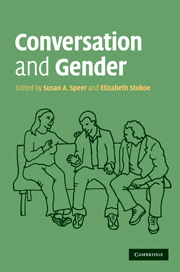Book contents
- Frontmatter
- Contents
- Contributors
- Data and transcription
- 1 An introduction to conversation and gender
- Part I Gender, person reference and self-categorization
- Part II Gender, repair and recipient design
- Part III Gender and action formation
- Part IV Gender identities and membership categorization practices
- 11 Accomplishing a cross-gender identity: A case of passing in children's talk-in-interaction
- 12 Engendering children's play: Person reference in children's conflictual interaction
- 13 Being there for the children: The collaborative construction of gender inequality in divorce mediation
- 14 Gender as a practical concern in children'smanagement of play participation
- References
- Author index
- Subject index
13 - Being there for the children: The collaborative construction of gender inequality in divorce mediation
Published online by Cambridge University Press: 05 June 2012
- Frontmatter
- Contents
- Contributors
- Data and transcription
- 1 An introduction to conversation and gender
- Part I Gender, person reference and self-categorization
- Part II Gender, repair and recipient design
- Part III Gender and action formation
- Part IV Gender identities and membership categorization practices
- 11 Accomplishing a cross-gender identity: A case of passing in children's talk-in-interaction
- 12 Engendering children's play: Person reference in children's conflictual interaction
- 13 Being there for the children: The collaborative construction of gender inequality in divorce mediation
- 14 Gender as a practical concern in children'smanagement of play participation
- References
- Author index
- Subject index
Summary
Introduction
The problem of gender inequality is often conceived in terms of relationships between variables, social forces, socialization, power and so on. These analyses beg the question of how inequality is created in particular instances in everyday life. It is through talk that much of the construction of gender inequality occurs and is perpetuated. However, research on gender inequality that compares the interactional styles or behaviours of males with females ignores the fundamentally interactional nature of human action. Rather than focusing on whether males or females typically perform different types of actions, or how individuals construct gender, researchers should study how gender inequality is collaboratively constructed by participants in interaction (e.g., Kitzinger, 2000a; Stockill & Kitzinger, 2007).
The social process of divorce mediation is a particularly salient context in which to examine how participants in interaction make gender relevant, because it is a situation in which the family is in transition. Participants use their experiences of family and the range of typical family structures that occur in their culture as background assumptions to shape and justify their actions. Participants construct and use links between gender and spousal and parental roles as they make claims and justify positions. These connections are not mechanistic; they are constructed by participants in the course of the interaction.
In this chapter, we will show how participants' actions in a divorce mediation session led to an instance of inequality in which the wife was disadvantaged during the interaction relative to the husband.
- Type
- Chapter
- Information
- Conversation and Gender , pp. 272 - 293Publisher: Cambridge University PressPrint publication year: 2011
- 3
- Cited by



